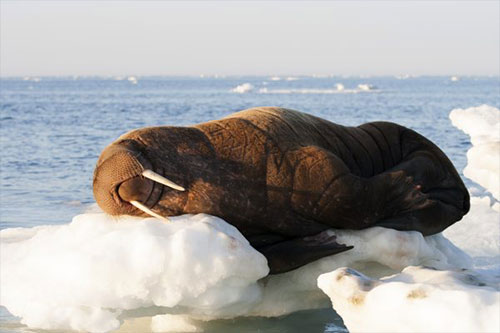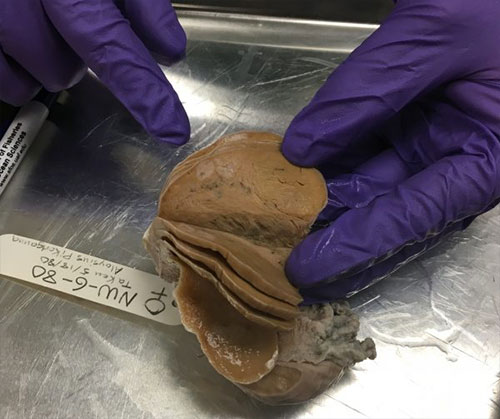
Tooth collections offer clues about walrus reproductionBy LAUREN FRISCH
September 07, 2018
Earlier this summer, I planned an interview to learn about a student project looking at zinc concentrations in walrus teeth. Things have certainly escalated since then. University of Alaska Fairbanks College of Fisheries and Ocean Sciences graduate student Casey Clark is studying how zinc concentrations in the teeth of female walruses may reveal valuable information about when a walrus first ovulated. Clark and his team believe ovulations earlier in life indicate that enough resources are available for population growth.
By cross-checking zinc levels with how many times a walrus ovulated over her reproductive lifetime, they are able to see how historical rises and falls in walrus populations are linked to changing zinc concentrations in teeth. This is where the walrus ovaries come in. Hormones created in the tennis ball–sized ovaries of a walrus during ovulation and pregnancy leave a permanent mark if the egg is not fertilized or when the pregnancy ends. As CFOS professor Lara Horstmann sat at my desk flipping through one of her sliced ovaries like pages in a book, these marks were clear even to my untrained eyes. Horstmann’s team counts the hormone structures and the marks they leave to estimate how many times a walrus ovulated during her lifetime. Clark and Horstmann are working with UAF Institute of Northern Engineering professor Nicole Misarti to better understand what age at first reproduction may reveal about the relative availability of food. It could also reveal how close a population may be to its carrying capacity, which is the population size that can be sustained based on food availability and other environmental conditions. “If a population is doing really well, with low stress and abundant food, animals will grow quickly and reproduce at a younger age,” said Clark. “In contrast, if there are too many walruses for the amount of food available, it can take longer for each animal to grow enough to reach a place where they are capable of reproducing.” For resource managers, the ability to track onset of reproduction could help predict how populations are likely to rise and fall, which is vitally important for subsistence hunters in the Arctic. “If you have a lot of walruses, but they are reproducing later in life, this could suggest that the population is approaching carrying capacity,” Clark said. Clark is working with approximately 150 walrus teeth from the University of Alaska Museum of the North, Smithsonian Institution and Alaskan subsistence hunters. The work is funded by the National Science Foundation, Bureau of Ocean and Energy Management, Coastal Marine Institute and the Biomedical Learning and Student Training program. Just as trees grow annual rings, teeth grow new layers every year. Researchers count the growth layers in teeth to determine how old a walrus was when its tooth was collected. Elements stored within different layers of the teeth can reveal how environmental conditions varied over the course of a walrus’s life. To see these layers, Clark slices each tooth down the middle in the widest, most uniform spot. Then the researchers sit in a room with a photo of the tooth’s cross section projected on a large high-definition screen. They count growth layers in each tooth on three separate days to make sure their age estimates are consistent. Unlike seeing the scar tissue in the ovaries, it was much harder for me to distinguish growth layers in the teeth when I joined the researchers for one of their “tooth days.” While some layers were dark and clear in the projected images, others were light or discontinuous throughout the tooth. Once the growth layers for each tooth were documented, the researchers measured zinc levels in each layer. Results showed that while male walruses gradually accumulate zinc in their teeth over time, females reached an inflection point pretty early in their lives that enabled them to accumulate zinc much more rapidly.
Horstmann speculated that this might be linked to sexual maturity, as zinc is known to be critical for both pregnancy and development. “Female bodies require much more zinc during pregnancy,” Horstmann said. “We are still working to determine the mechanism that is causing this dramatic change in uptake.” Once the researchers had an idea of what these fluctuating zinc levels in teeth might represent, they turned to the ovaries to double-check. During pregnancy, animals create a corpus luteum in their ovaries, which secretes a hormone that maintains the placenta. When the pregnancy ends, the corpus luteum turns into scar tissue, called corpus albicans. Horstmann has access to an array of preserved walrus ovary samples that were taken from the same animals whose teeth were collected. The ovaries were sliced into thin sections so you can flip through them to identify the corpus luteum and multiple corpora albicantia in each sample. Using the estimated tooth age, zinc concentrations in the tooth layers, and the total number of corpora in the ovaries, Clark determined that a walrus gets pregnant an average of once every 1.5 years during her reproductive lifetime. This result is consistent with general knowledge about walrus reproductive cycles. The researchers found that age of first reproduction fluctuated in a way that appears to correlate with changes in the size of the population. Reproductive maturity was early in the 1950s, when walrus numbers were low due to commercial hunting but resources were plentiful. In the late 1970s and early 1980s, the population rebounded to a point where walruses were believed to have exceeded carrying capacity. At this time, age at first reproduction was late in life, likely because it took longer for animals to grow large enough to be able to sustain a pregnancy. The population declined from that point until the 1990s. As a result of the decline, food became more abundant and the age at first reproduction dropped once more. “We don’t really have a good handle on what’s happening now,” Clark said. “The hunters say there are a lot of walruses out there, and they are still fat. It would be great to be able to use timing of reproductive maturity to track when the population is close to carrying capacity and better predict when the population is likely to decline in the future.” The researchers are eager to consider whether zinc measurements in teeth can be used to study reproductive maturity in other animals as well, or if these trends are specific to walrus populations. “Right now, we don’t know whether this phenomenon is unique to walruses, if it’s a marine mammal thing, or if it’s something that happens in all animals, but we’re eager to find out,” said Clark. Personally, I wish the team could study bowhead whales next. I hear they have giant ovaries, but alas, no teeth.
Representations of fact and opinions in comments posted are solely those of the individual posters and do not represent the opinions of Sitnews.
|
|||||

